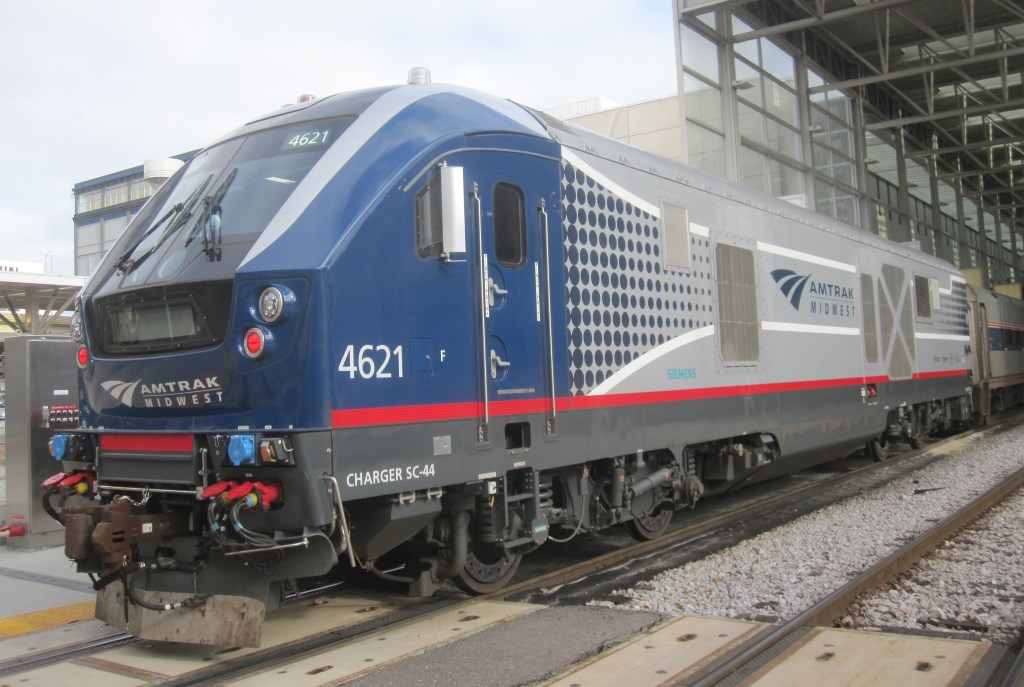Plan Provides Amtrak Service for Foxconn
DOT has plan and Ald. Bauman pushes it, demanding Walker address it.
The massive Foxconn plant planned for southern Racine will someday employ 13,000 people if everything goes to plan. But what’s not part of that plan is any sort of mass transit system to get workers to the 20-million-square-foot campus. Milwaukee Alderman Robert Bauman aims to change that.
The alderman is pushing to advance a state plan to expand Amtrak’s Hiawatha Service line from seven trips a day to 10 as a cost-effective option to get workers to the electronics manufacturer’s $10 billion campus. The line, which provided 829,000 rides in 2017, bisects a portion of Foxconn’s planned campus, with a station in Sturtevant approximately two miles away. Its expansion is “true low hanging fruit,” says Bauman.
Governor Scott Walker‘s Foxconn subsidy package includes adding a lane to Interstate 94 between Racine and Milwaukee at a cost of approximately $500 million. The state has applied for a $240 million federal grant to support the work. An additional $134 million is budgeted to be spent on improving local roads and highways near the campus. No portion of the state subsidy includes funds for mass transit.
Eric Lynde of the Southeastern Wisconsin Regional Planning Commission told members of the city’s Public Transportation Review Board that it’s possible Foxconn could use shuttles to transport workers from the station to the campus. But doing so without expanding the line could be difficult.
Arun Rao, Passenger Rail Implementation Manager for the Wisconsin Department of Transportation, told the committee that morning and evening trains routinely run at capacity, with passengers required to stand in the aisles. Adding a car to the trains, which currently seat 408 passengers, is prohibitively expensive because an additional conductor would be legally required.
“Why does it cost $200 million to add three trains? That is a common sense question until you read your study,” Bauman told Rao.
“When you add an 80 miles-per-hour passenger rail to a corridor it takes up a lot of capacity,” Bauman explained. Operating in the corridor today, which is owned by Canadian Pacific in Wisconsin and the publicly-owned Metra commuter railroad in Illinois, are 65 Metra trains, 25 freight trains and 16 Amtrak trains (the Hiawatha and Empire Builder).
The $195 million estimated project cost would go towards nine projects, three of which are in Wisconsin. They include $10 million for a second platform at the Milwaukee Airport station, $5 million for centralized traffic control signaling improvements near the Milwaukee Intermodal Station, and $44 million to build the Muskego Yard bypass. The bypass would allow most freight trains to avoid having to run through the Milwaukee Intermodal Station and instead route through the Muskego Yard in the Menomonee Valley via a rail line that parallels W. Florida St.
The federal government could pay for up to 50 percent of the project’s cost. To operate the line today, Wisconsin pays for 75 percent of the cost, with Illinois paying 25 percent. Hiawatha revenue pays for 75 percent of the service’s cost; a cost-recovery ratio far ahead of the Milwaukee County Transit System (26 percent) or the streetcar (20 percent). Final design, which would start after the Federal Railroad Administration signs off on the plan, could lower the project’s cost through formal engineering work.
Political Priorities Favor Highways Over Rail Despite Cost
According to a timeline presented by Rao, service could be up and running by 2023. That’s years later than the Interstate 94 expansion.
“Some projects are on the fast track, some are on no track,” says Bauman. The alderman says that’s because of political pressure. The rail project could be sped up if given the same state and federal push.
“This is upgrading a railroad line that has been in existence since 1872, so it’s not like you’re plowing fields and building new infrastructure,” said Bauman. “You’re going to have a shovel-ready project very shortly to expand this very important rail line that has been serving Milwaukee for over 100 years. The opportunity to expand service, to provide more flexibility for commuters and it goes right through the Foxconn property. We don’t have to talk about building new rail lines or adding massive bus service; we have existing public transportation infrastructure right at the front door and no one is talking about it.”
Would the Governor support such a measure? In December, Bauman said that Walker’s powerful lieutenant, the Department of Administration Secretary Scott Neitzel, in a conversation with the alderman characterized transit as “a government solution” to the workforce problem. Bauman told the committee “You spend $3 billion on attracting a private company and you think transit is a government solution?”
Bauman says the irony is that the rail infrastructure is the cheapest piece of new infrastructure compared to the $634 million in highway expansion. It would allow drivers to park at any station along the line and use existing transit infrastructure to commute to either the Milwaukee Intermodal Station or Milwaukee Airport Railroad Station.
He notes employees at Foxconn’s new downtown office building could take the streetcar’s lakefront spur to the train station, the Hiawatha to Sturtevant and be a short walk or ride to the manufacturing campus.
The alderman suggested that Foxconn could subsidize a portion of the fares for employees to ensure the service is affordable.
If you think stories like this are important, become a member of Urban Milwaukee and help support real independent journalism. Plus you get some cool added benefits, all detailed here.
More about the Foxconn Facility
- Foxconn Acquires 20 More Acres in Mount Pleasant, But For What? - Joe Schulz - Jan 7th, 2025
- Murphy’s Law: What Are Foxconn’s Employees Doing? - Bruce Murphy - Dec 17th, 2024
- With 1,114 Employees, Foxconn Earns $9 Million in Tax Credits - Joe Schulz - Dec 13th, 2024
- Mount Pleasant, Racine in Legal Battle Over Water After Foxconn Failure - Evan Casey - Sep 18th, 2024
- Biden Hails ‘Transformative’ Microsoft Project in Mount Pleasant - Sophie Bolich - May 8th, 2024
- Microsoft’s Wisconsin Data Center Now A $3.3 Billion Project - Jeramey Jannene - May 8th, 2024
- We Energies Will Spend $335 Million on Microsoft Development - Evan Casey - Mar 6th, 2024
- Foxconn Will Get State Subsidy For 2022 - Joe Schulz - Dec 11th, 2023
- Mount Pleasant Approves Microsoft Deal on Foxconn Land - Evan Casey - Nov 28th, 2023
- Mount Pleasant Deal With Microsoft Has No Public Subsidies - Evan Casey - Nov 14th, 2023
Read more about Foxconn Facility here
Eyes on Milwaukee
-
Church, Cupid Partner On Affordable Housing
 Dec 4th, 2023 by Jeramey Jannene
Dec 4th, 2023 by Jeramey Jannene
-
Downtown Building Sells For Nearly Twice Its Assessed Value
 Nov 12th, 2023 by Jeramey Jannene
Nov 12th, 2023 by Jeramey Jannene
-
Immigration Office Moving To 310W Building
 Oct 25th, 2023 by Jeramey Jannene
Oct 25th, 2023 by Jeramey Jannene
Transportation
-
MCTS Adds 28 New Buses
 Jul 13th, 2024 by Graham Kilmer
Jul 13th, 2024 by Graham Kilmer
-
MCTS Designing New Bus Shelters
 Jul 10th, 2024 by Graham Kilmer
Jul 10th, 2024 by Graham Kilmer
-
MCTS Updates RNC Bus Detours To Better Serve Downtown, Riders
 Jul 9th, 2024 by Jeramey Jannene
Jul 9th, 2024 by Jeramey Jannene























And suddenly, republicans support mass transportation and trains! It’s a miracle! After decades of demonizing and rejecting and naysaying everything and anything to do with evil trains and mass transit. And all it took was Career Politician Scott Walker selling out the state taxpayers by handing over 4.5 Billion of our tax dollars in corporate welfare to a foreign company. All aboard the Shame Train!
Dump Walker 2018
This only makes Walker’s opposition to the Madison train extension look worse, since much of what they are now looking for was INCLUDED in the project that Walker opposed.
The Madison project wasn’t just train new service between Milwaukee and Madison; it also included more trains between Milwaukee and Chicago—specifically increasing that service from 7 to 10 daily roundtrips (on roughly the same schedule being proposed today).
The capital costs for that expansion would have been 100% federally funded. (The feds even laid out $133 million to cover any cost overruns.) Now Wisconsin hopes to get 50% federal funding for much of the same work.
Part of the $195 million is for an additional trainsets. (It uses 2 trainsets today but would need at least 3 to cover the expanded schedule.) As we know, Wisconsin already paid for 2 new Talgo trainsets, but then refused to take delivery, and the Madison extension project included money for 2 additional Talgos—for a total of 4 new trainsets (100% paid by Washington).
The only thing Wisconsin taxpayers got for the tens of millions spend on the 2 Talgos was a promise to return some of that money if and when Talgo re-sold the trainsets. But Talgo leased those trainsets instead so Wisconsin gets nothing back.
You can see the proposed 10-daily-roundtrip schedule here:
http://wisconsindot.gov/documents/projects/multimodal/rail/train-sched.pdf
There are two sets of schedules. One assumes the track speed limit remains at 79 mph while the other shows what would happen if it upgraded to support 90 mph trains in parts. Going to 90 mph only cuts trip times by 2 minutes.
The schedules include a late-night train (leaving 10:30 or later) in each direction 7 days/week which would help people working 2nd or 3rd shift. While the one-way cash fare to Sturtevant is $10, Amtrak sells monthly passes for $184 (or $167 if you board at the airport) which brings down the cost substantially.
@Transit Rider, that’s Career Politician Scott Walker for ya! At the time Career Politician Walker said the operating costs would be too high. In reality they were actually very modest compared to what we would’ve received but of course they won’t be too high now. Hypocrites in broad daylight!
Dump Walker 2018
This should have been thought out before the street car as well. The county could have expanded parking areas at the airport and more people could take the train into the city and the street car to work. With the revenue from the expanded parking at the airport maybe we wouldn’t need a wheel tax or have to stick ugly parking meters in the county parks.
Related to the Republican fear/distain for mass transit–we’ve been having a really fun time down here in Chicago mocking the WEDC’s upcoming ad campaign to lure Chicago millennials to Wisconsin. (NOTE: No one is mocking Milwaukee, Wisconsin, etc. Absolutely everyone I’ve met down here over the past three years LOVES MKE and WI!)
That said, the campaign’s focus on Chicago’s longer commute times, which are 10 minutes longer that “Wisconsin” commute times.
http://www.urbanophile.com/2018/01/16/would-you-move-to-wisconsin-to-save-ten-minutes/
http://www.chicagotribune.com/news/columnists/kass/ct-met-wisconsin-advertising-kass-0111-story.html
Seriously, what’s a WI commute time and why are we comparing it to that of one of America’s biggest and best cities? And, we’ve see campaign description and ad mockups complaining about crowded trains–but the pictures actually show lovely, uncrowded trains. The only problem is the forlorn expressions on some young white kids’ faces. Seriously, Earth to WEDC: The “L” is not a commute problem, it’s a commute solution. I ride it at least 2x per day during rush hour. It’s how we get around quickly and affordably–without NEEDING to get in a car and drive. You know what happens on the “l” during rush hour–video games, and reading the paper or a book on smartphones–and also a little friendly “cruising” among riders who might fancy each other. Packed to the gills and totally fine.
From one article down here: “We know from research that millennials in the Chicago market have told us their pain points are commute times and cost of living,” Tricia Braun, chief operating officer of the Wisconsin Economic Development Corp., said Wednesday. “I think they will find a difference in those two aspects of quality of life.”
Yeah, but you know what the big “pleasure point” is for millennials? Authentic city experience. (And, walkable neighborhoods. And mass transit.) Chicago has it, and while Chicago is more expensive from a Milwaukee, Waukesha or Janesville perspective, it’s inexpensive compared to NYC, LA, SF and other top-tier cities, and that’s what many Chicagoans compare themselves to. Chicago has the best Quality-to-Price ratio of any big city in the country. We all love Milwaukee and Madison, and even Kenosha and Sheboygan, but they are completely different experiences. Wonderful, and different. (Seriously, people, Chicagoans LOVE Milwaukee and Wisconsin. Get over it.)
Like one writer has pointed out, this ad campaign seems to have been created to some middle-aged white guy in the suburbs trying to imagine what city-loving millennials want (based on what he’s heard on TV). He’s no doubt a car driver, God bless him.
Walker turn down down our federal taxes dollars (900,000,000.00) million and now wants to tax us twice because the Koch handlers told Walker to turn our money down. Wisconsin we have become lazy fools to believe this con man
Ok…I get most of this…but adding one car is prohibitively expensive because we would have to add one more conductor…compared to millions of dollars for more trains? I am all for more trains, better tracks and a better experience, but adding a car and an employee is too much $$$??
@Ed Heinzelman, I think one article I read said that federal regulations limit the number of cars per conductor, and adding one more to the Hiawatha would trigger this regulation. I wonder if it’s worth checking into it to see if some sort of waiver might apply. Given the recent train accidents over the years, I’m a bit reluctant to consider waiver if there are legitimate safety concern.
@midnightson – I am not doubting that adding a car triggers a safety requirement for another conductor and I am not suggesting that’s a bad thing. But what could another conductor cost per year with benefits? $150,000 compared to millions for three more round trips? Just seems to me that one more car and one more conductor in the short term would be relatively cost effective and not prohibitive.
It’s amazing to think that if City of Milwaukee was not undermined left & right by the state over the last 25 years, we’d have 1) a 250+ million dollar (1991 dollars) light rail network in the city funded through the Federal ISTEA money, 2) a restored Milwaukee-Racine-Kenosha commuter rail line with with dedicated funding, 3) higher speed rail from Chicago to Madison via Milwaukee with more trains per day plus restored passenger rail to west suburbs, 4) surface level champs elysees-style boulevards where 794 currently stands and corresponding redevelopment throughout downtown and the 3rd ward.
Instead we got bloated highway projects, costing tax payers at least twice as much.
Ed Heinzelman, adding one conductor per train would involve hiring at least 6 additional conductors (1 for each of at least 6 crews). And that would not be the only added cost.
The Hiawatha operates about 16 hours/day which suggests 2 shifts per day (14 shifts/week) or 3 full-time crews to cover those 14 shifts.
And that’s 3 crews per operating trainset (physical train), and the Hiawatha operates 2 trainsets, so you’re up to at least 6 new, full-time conductors, and probably 7 when you consider vacations and sick days. And there’s also the cost of 2 new cars (1 per trainset) at over $1 million each.
Then there’s the issue of “spare” equipment. Transit operators and airlines need more vehicles than they operate at their busiest time. (That’s why, for example, Milwaukee is buying 5 streetcars, even though we will never have more than 4 on the street at once.) The Hiawatha either has a dedicated spare trainset sitting in Chicago or it draws from Amtrak’s Chicago-based equipment pool.
A dedicated spare trainset would need an added car, too. If, on the other hand, the Hiawatha relies on a wider pool of spare trainsets in Chicago, there’s the question of whether a longer Hiawatha trainset would be incompatible with the other short-haul routes out of Chicago. If so, there might be the expense of acquiring another complete trainset to create a dedicated spare.
Then there’s the issue of station length. Longer trains need longer stations. While not a problem in Milwaukee and Chicago, what about Mitchell Airport, Sturtevant, and Glenview? Lengthening them means millions (if not tens of millions) in added costs, especially if the extension triggers new ADA requirements for the existing station.
Finally, there’s the issue of locomotive capacity—how many cars can a single locomotive pull and still meet the schedule? If another locomotive is needed for each trainset, that nearly doubles the fuel cost and locomotive maintenance expense and requires tens of millions for 3 new locomotives.
While Hiawathas appear to use 2 locomotives—one on each end—one of them (typically on the south end) is actually a “non-powered cab unit” (NPCU). The NPCU is the shell of an old locomotive with its diesel engine removed and replaced with room for checked baggage. It retains its engineer compartment and controls. On southbound runs, the train is pushed from the engine (in back) but controlled by the engineer in the NPCU. On northbound runs, the NPCU is simply a baggage car.
To the best of my knowledge, there is no statutory requirement regarding crew sizes; rather, that is based upon Amtrak’s labor agreements. As for whether it would be easier to change labor agreements than federal law or regulation, well, I’ll leave that up to others to guess.
There is not a spare (3rd) Hiawatha trainset. The Hiawatha trainsets, as with other Midwest corridor trains, utilize Amtrak’s Chicago-based Midwest equipment. Amtrak’s equipment situation is tight but it might be possible to add an additional car to each of the two Hiawatha trainsets. That would, however, increase the equipment-use charges that Wisconsin (75%) and Illinois (25%) pay Amtrak. If (when?) the additional cars ordered by a number of Midwest states (not including Wisconsin) and California ever arrive, that would free up quite a bit of regular Amtrak equipment.
If the trains could be lengthened, the only platform that would need to be extended is at Sturtevant. The Mitchell Airport platform was lengthened a few years ago as one of the few projects funded after the Madison extension was killed. And the Glenview platform is regularly served by longer Metra trains. And, as mentioned, the Chicago and Milwaukee platforms are more than long enough.
Personally, I’d generally prefer running shorter trains more frequently than longer trains less frequently. But if we’re just considering the costs involved, I’m not sure it’s so clear-cut that it’d be cheaper to add 3 trains/day than to add an additional car to the existing trains.